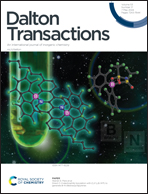1D Cu(i)-based chiral organic–inorganic hybrid material with second harmonic generation and circular polarized luminescence†
Abstract
In recent years, organic–inorganic hybrid materials have demonstrated exceptional performance in nonlinear optics, attracting widespread attention. However, there are relatively few examples of coordination compounds synthesized with Cu as the metal center that exhibit excellent nonlinear optical properties. In this study, we successfully synthesized a pair of enantiomers named R/S-Cu2I2 by reacting chiral ligands with CuI. The crystal structure reveals a one-dimensional copper-iodide chain structure built by Cu2I2 clusters, and its ordered arrangement in space provides not only a strong second harmonic generation (SHG) signal (1.24 × KDP) but also a large birefringence (0.15@1064 nm). Under excitation at 395 nm, the crystals exhibit red fluorescence peaked at 675 nm. The CD spectra of R/S-Cu2I2 show a distinct mirror-symmetric Cotton effect, and their CPL signals are corresponding and opposite in the emission range, with a maximum glum of approximately ±2.5 × 10−3. Theoretical calculations using density functional theory were also carried out to enhance our understanding of the correlation between their structures and optical properties.



 Please wait while we load your content...
Please wait while we load your content...